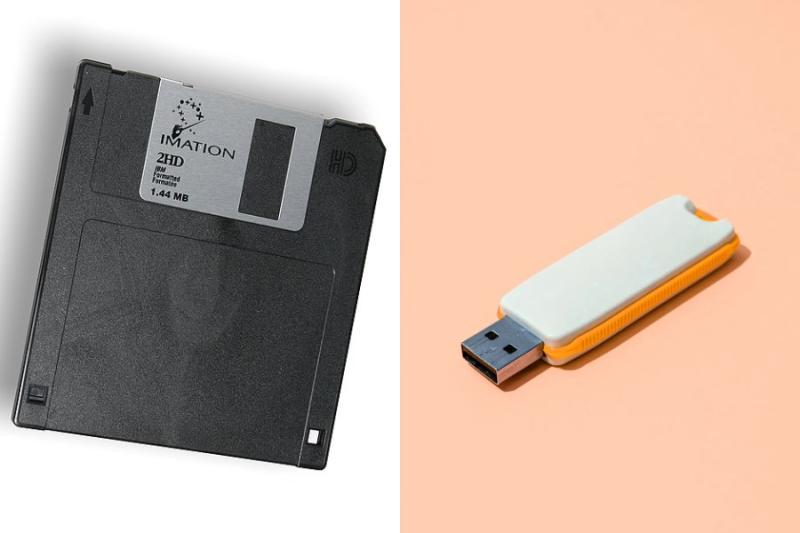The main difference between a floppy disk (also called a “diskette”) and a flash drive is in how they store data, how much space they can hold, and how they look. Floppy disks use magnetic storage and can only hold up to 1.44 megabytes of data. They have a flexible magnetic disk inside a square case made of plastic. Flash drives use solid-state memory (NAND-based flash memory) that can hold much more data, from a few megabytes to many terabytes. Flash drives are small, portable devices with a USB connector that makes it easy to move data. Compared to floppy disks, they can read and write data faster, last longer, and are more reliable.
What is a Floppy Disk?
A floppy disk, also called a floppy, diskette, or simply disk, is a magnetic storage medium mostly used to store and move data from the 1970s to the early 2000s. The floppy disk is a thin, flexible disk made of plastic that is covered with magnetic material and put in a square or rectangle case made of plastic. The magnetic coating makes it possible to store digital information in a format called binary (1s and 0s).
At first, there were both 8-inch and 5.25-inch floppy disks, but the 5.25-inch ones were more common. In the 1980s, the 3.5-inch disk became the standard because it was small, had a solid case, and could hold more data. People often used floppy disks to store documents, move files, and pass out software.
But as higher-capacity storage devices like CDs, DVDs, USB flash drives, and cloud storage became more popular, the floppy disk’s use dropped dramatically. Today, floppy disks are mostly seen as a throwback to the early days of personal computers.
What is Flash Drive?
A flash drive is a portable device that uses flash memory to store and transfer digital information. It is also called a USB drive, thumb drive, or pen drive. Flash drives are popular for personal and business use because they are small, light, and easy to carry.
Flash drives have a printed circuit board inside a durable housing made of plastic, metal, or rubber. They also have a USB connector that lets them connect to computers and other devices. Flash drives are different from hard drives and optical disks in that they don’t have any moving parts. This makes them less likely to break and makes it easier to access data.
Flash drives can hold files like documents, photos, videos, and software. Their storage sizes range from a few megabytes to several terabytes. Many people also use them to start operating systems, back up data, and share files between devices.
Flash drives use NAND-based flash memory, which lets data be stored and retrieved even when the device isn’t plugged into a power source. Flash drives are a popular alternative to older ways of storing data like CDs and floppy disks because they don’t lose their data when the power goes out.
Difference Between Floppy Disk and Flash Drive
There have been many types of portable data storage over the years of computers, but floppy disks and flash drives stand out as being particularly unique. There are four primary distinctions between the two: data storage capacity, durability, data transfer speed, and underlying technology.
Storage Capacity
The most common type of floppy disk, measuring 3.5 inches in diameter, can only store 1.44 megabytes of data. However, flash drives have much larger storage capabilities, from only a few megabytes to many terabytes, making them ideal for storing massive amounts of data and media.
Durability
The floppy disk is a magnetic storage medium housed in a plastic container with a metal sliding lid. Environmental factors like dust, temperature swings, and magnetic fields can corrupt data stored on them. As there are no moving parts in a flash drive, the device is more robust, can withstand more physical damage, and is less likely to lose data.
Data Transfer Speed
Transferring data from a floppy disk might take seconds to a minute. Because of developments in NAND memory technology, data transmission rates on flash drives have increased dramatically, making them ideal for current applications and large file transfers.
Technology
Data is read or written to a floppy disk using a magnetic storage head that spins above the magnetic disk surface. NAND flash memory is used in flash drives; it is a form of non-volatile storage that keeps data even if the device loses power. These technological advancements have made flash drives more portable, efficient, and trustworthy than their floppy disk predecessors.






